Nest boxes for birds
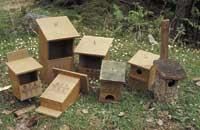
Some of the numerous species of birds that inhabit the forests and forest plantations of the Basque Country are the troglodytes, that is, they nest in wooded holes. Birds, for example, drown in carpet holes. But most species of nesting birds nesting in the holes are not able to make their own hole and should look for the right hole for nesting.
Among them are the big charcoal, the pine charcoal, the small charcoal, the blue amilotx, the moñudo amilotx, the common bird, the tick or the neck.
The availability of natural holes is very important, to the extent that the density of troglodyte wild birds depends on the density of the holes, although above the minimum density of holes other factors such as feeding or territoriality are affected. In addition, not all natural holes are suitable for nidification. They should offer safety against predators or parasites should not condition the success of reproduction. In short, the right natural holes are a scarce resource and birds must compete for a hole.
In addition to the nesting of birds in the holes of the trees, many other animals take refuge. Like the gray liron and the smooth mouse. In ancient forests there are plenty of gaps, but most of the current forests of Bizkaia and Gipuzkoa are young forests and forest plantations. Therefore, the holes suitable for the reproduction of wild birds are very scarce: they cut the trees before the holes appear and, in addition, prunings prevent the formation of holes. That is what makes it very difficult to find a suitable hole and, if not found, the failure of reproduction can become too large to maintain viable populations. For example, if the holes do not offer security against predators.
Artificial nest boxes
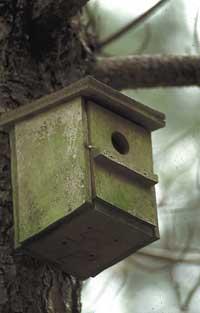
Humans have made nest boxes to help birds. The nest boxes are wooden or cork boxes that can replace the natural holes and are located in places where there are no holes or are very scarce. The use of nest boxes depends on demography, bird distribution and abundance of natural holes.
In the first quarter of 1991 we placed in nine different places 1,950 nest boxes of different types of conglomerate. Two and a half years later, in the last quarter of 1993, we placed 1,172 single type cork nest boxes in fifteen places (Table 1). On the one hand, we place the conglomerate nest boxes of 3 to 4 meters. The “Gerri-txori”, “Txantxangorri” and “Saguzar” nest boxes are cast with iron nails on the logs and others with metal keys.
To avoid the influence of rains and stronger winds, we put them in the east and southeast direction. During the last quarters of 1991, 1993 and 1994, we monitored breeding birds and inspected boxes. On the other hand, the cork nest boxes were sewn with steel nails, placed from 4 to 5 meters. We inspect the boxes in the last quarters of 1993 and 1994 and track birds during the breeding season of 1994.
Box density is maintained everywhere. The follow-up of the breeding season allowed us to know which breeding species used each type of nest box. After the breeding season, after the inspection of the nest boxes, the degree of use was known, that is, the percentage of the boxes containing the nest. The nests found in the boxes were removed the following year to facilitate the use of the nest boxes.
Use of nest boxes
The use of cork nest boxes was 20.83% and 25.00%, taking into account and without counting missing nest boxes, respectively. The use of each type of cluster box can be seen in Table 2 and both in the boxes of each type and in Table 3 made by bird species.
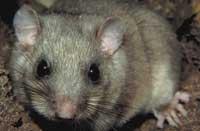
Of the seven types of conglomerate nest boxes, only three had a high degree of use: “Gerri-txori”, “Parido Txiki” and “Parido Grande”, the most suitable for those birds (troglodyte birds) that may have difficulty nesting in young forests and forest plantations. The “Saguzar”, “Belatz gorri” and “Urubi” nest boxes did not have the expected success, as neither bats nor red hawks or urubis used them. In addition, in general, the degree of use was very low, as well as the type “Txantxangorri”. The boxes of type “Red Kestrel” and “Urubi” that we put were very small and, once the investigation was completed, another type of urubia was very successful, probably because it was much larger.
The percentage of missing or broken conglomerate boxes was to take into account: 10.90% in the 1991 review, 59.85% in 1993 and 74.46% in 1994. That is, only a quarter of the nest boxes lasted four years. The nest boxes nailed to the trunks lasted longer, especially those of type “Gerri-txori” and “Txantxangorri”. We have detected that the fibrapan cluster is very inadequate. In fact, fibrapan absorbs water and iron nails oxidized and broke. Finally, the nest boxes cracked and fell.
The most winning birds were the big charcoal and the blue amilotx, mainly thanks to the nest boxes “Gerri-txori”, “Parido txiki” and “Parido handi”. The “txantxangorri” box is suitable for txantxangorris and grey fly birds. However, these species would have no problem finding suitable places, as they are not strict troglodyte birds, so they can nest elsewhere.
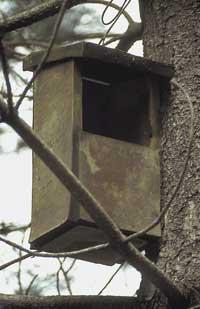
The degree of use of the nest boxes of cork was similar to that of the “Parido” conglomerates, but unlike the nest boxes of cork, those of conglomerate cracked and fell by rain.
We also analyzed the percentage of use of cork boxes based on habitat. Apart from the missing nest boxes (193) and those existing in heterogeneous habitats (153), 826 nest boxes were considered located in five forest plantations and two natural forests (Table 4). The percentage of use of nest boxes was very variable depending on the habitat. The forest plantations were very young and the trees were cut before the holes appeared. In the oaks the trees were also very young. In the oak groves, on the contrary, the oldest.
Using biostatistics (square ji, p 0.05, n=6) it was observed that it depended on the habitat of the degree of use of the boxes (Table 4). Surprisingly, although the oak tree is the habitat with the highest number of natural holes, they were the ones with the highest percentage of use of the boxes. In fact, the percentage of use of the nest boxes depends on the density of the troglodyte birds and the abundance of natural holes presented by the oak trees, which allowed the use of nest boxes with large numbers of birds. In addition, knowing the phylometric behavior (propensity to reproduce at the place of birth), it is possible that many of the birds born in oak groves have nested in nest boxes of the same oak.
On the other hand, in low-density habitats of troglodyte birds, probably associated with forest plantations, the number of birds willing to use nest boxes will be reduced, which would explain the scarce use of other habitats. Other studies have also shown that the use of nest boxes increases progressively over the years (as bird proliferation occurs in forest groups) and that in forest plantations often the density and diversity of birds in the natural forest is not reached. In our research the most pleasant surprise was to find grey lirones.
In 1991, in a wild pine forest repopulation with numerous quejigales in the Salbada massif, we found two grey lirones in a conglomerate nest box and two in a conglomerate nest box in a Gorbeia pine forest plantation, very close to a beech. On November 1, 1994, in the nest boxes of cork, we found numerous lirons in the alder and beech trees next to the stream of Karrantza.
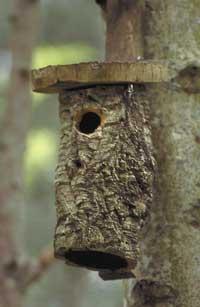
We found ten grey lirones in eight nest boxes. Two other nest boxes were full of chestnut bark. It seems that the most important food in this place are chestnuts. On the other hand, in the oak groves of the same municipality, six willow mice were also found.
Finally, we would tell whoever wants to make and place nest boxes that, in addition to those broken by very disrespectful people, it is also possible to find broken nest boxes. We found 50 conglomerate nest boxes (5.11% of those in the trees in the revisions) broken with pecking, according to biostatistics, with a polluting position (tendency to appear together).
In fact, in the four groups of nest boxes (9.98% of the nest boxes installed) 68.00% appeared labeled with pecking. From this box of 50 nests, 11 were found the nest and the others were empty. Although we do not certify it, it is possible that the cause of the damage is the big bird, since in reproductive time this bird often eats eggs and chickens of birds. In addition, the nest box learns to relate to possible prey.





